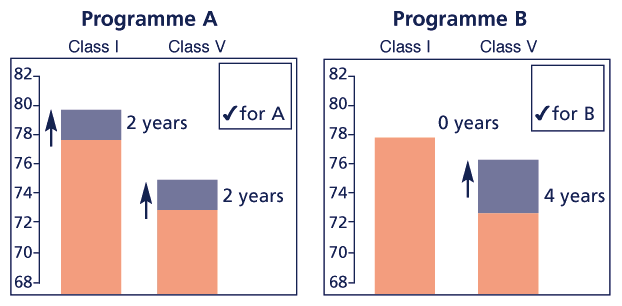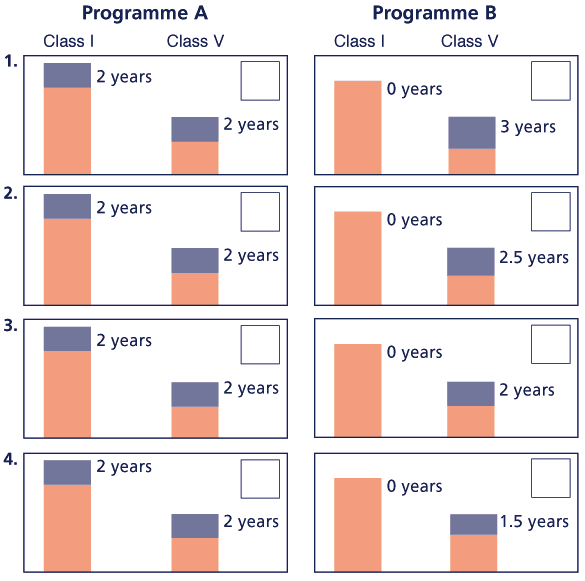 |
Close
window to return
|
Issue 7, April
2001, pp.14-15.
How
much do people care about health inequalities?
Paul Dolan and Rebecca Shaw
Introduction
Improving population health and reducing health inequalities are now the
central goals of public health policy in the UK. Many people welcome the
emphasis on equity, and would like to see even greater investment in tackling
health inequalities. However, tackling inequalities comes at a price,
in that it diverts government resources from other potentially beneficial
activities.(1) In particular, targeting more NHS funds at the reduction
of health inequalities may only be achievable at the expense of some reduction
in the total health improvement achieved by the NHS. The question, then,
for policymakers is: what proportion of the limited resources available
should they devote to the reduction in health inequalities as compared
to the maximisation of health?(2)
Our study offers evidence on whether ordinary people care about health
inequalities, and the extent to which they are prepared to sacrifice the
maximization of health gain in order to secure some reductions in inequalities.
A key part of the project is to establish whether it is possible to measure
people's views on this complex question. This article describes the methods
we have developed to do this and some preliminary findings.
What do people understand by a health inequality?
The early, qualitative stage of the study involved in-depth interviews
and focus groups.3 We asked respondents to think about the causes and
consequences of health inequalities, using graphical representations of
data and open-ended questions. Overall, the information on a range of
health inequalities was familiar and well-understood. However, all respondents
were surprised by the magnitude of the differences in health between social
classes ('I'm surprised that there is such a difference. The difference
is startling. It's a terrible thing'). The concept of fairness in health
was generally well-understood by respondents, enabling us to test more
formal means of eliciting preferences.
Developing methods of eliciting preferences
We developed and piloted a structured questionnaire, which asked respondents
to indicate the extent to which they were prepared to sacrifice some element
of total health gain in order to secure a health improvement for a particularly
disadvantaged group. Health was defined in terms of average life expectancy
and rates of limiting long-term illness, as the earlier qualitative research
demonstrated public familiarity with these ways of measuring health.
One particular element of the questionnaire (reproduced in Figure 1) asked
respondents to choose between two health care programmes. Each programme
was designed to reduce mortality in all social classes, but the extent
to which they targeted mortality in social class V varied.
Figure 1: Measuring views on health inequalities: the average life expectancy
question
As you might know, average life expectancy differs by social class.
There are differences between people in social class I (for example, doctors
and lawyers) and people in social class V (for example, road-sweepers
and cleaners). These two groups are more or less equal in size (they each
make up about 7% of the population).
Whilst actual life expectancy varies between individuals, on average,
people in social class I live to be 78 and in social class V they live
to be 73.
Imagine that you are asked to choose between two programmes which will
increase average life expectancy. Both programmes cost the same.
In the two graphs below the pink part shows average life expectancy, and
the blue part shows the increase in life expectancy. There is a separate
graph for each of the programmes.
As you can see, Programme A is aimed at both social classes and Programme
B is aimed only at social class V.
Please indicate whether you would choose A or B by ticking one box.

It may be that Programme B is less effective than we had first thought.
This will mean that the increase in life expectancy is less overall.
For each of the four choices below, please tick one box to indicate
whether you would still choose B, or whether you would now choose A.

Respondents are asked initially to choose between programme A, which increases
the life expectancy of both social groups by 2 years, and Programme B,
which increases only the life expectancy of social class V, but does so
by 4 years. Those respondents who choose Programme B are then offered
a succession of less attractive alternatives, in which the benefit to
Social Class V is steadily reduced. The intention is to identify at which
point (if any) the improvement in health for the disadvantaged group offered
by Programme B becomes unacceptable when viewed alongside the greater
overall improvement in health offered by Programme A.
Other respondents were presented with identical questions but related
to gender differences, rather than class differences, in health. This
enabled us to see whether people's aversion to inequality differs according
to the type (rather than magnitude) of inequality. To test further the
sensitivity of people's aversion to inequality, other respondents were
presented with the same life expectancy and long-term illness differences
across groups defined simply as the 'healthiest 20%' and the 'unhealthiest
20%' of the population.
The questionnaire was administered through 130 one-to-one interviews with
residents from the York area. While people found the questions challenging,
all respondents appeared to understand the questions and the questionnaire
was fully completed in all cases. We have subsequently developed a postal
survey instrument, based on a simplified version of the questionnaire.(4)
The results of the postal survey are still being analysed and are not
reported on here.
Some preliminary results
Our preliminary results from the interviews suggest that a majority of
respondents are prepared to sacrifice some total health gain in order
to reduce the stated inequality.5 For the majority who are prepared to
make such a trade-off, views differed on the point at which the benefits
to the less healthy group were not adequate compensation for the loss
in benefits overall. The median respondent (the one in the middle of the
range) is indifferent between people in social classes I and V living
on average to be 80 and 75, respectively, and these groups living to be
78 and 75.5, respectively. This means that people felt that a gain of
6 months to the worse off group could be regarded as equivalent to a gain
of 2 years to the better off. This is also the median response when the
sub-groups are defined in terms of the healthiest and unhealthiest quintiles
of the population. In contrast, when identical data are presented but
sub-groups are defined by sex, the median preference is to favour no targeting
of men at all. We found a similar picture when the questions were framed
in terms of long-term illness rather than life expectancy.(5)
There were no significant differences in attitudes towards tackling health
inequalities by education, gender and family responsibilities. For example,
those with educational qualifications were no less willing to target social
class V than those without qualifications, and women are no less willing
to extend the lives of men than are men themselves.
Policy implications
Overall, the results suggest that the majority of people are willing to
make trade-offs between efficiency and equity. However, there is a great
deal of heterogeneity in responses, and the strength and nature of an
individual's preferences are often sensitive to what inequalities exist
and where they exist. The later stages of the project are designed to
build on these findings and create a set of tools which policymakers can
use to elicit public preferences. The intention is to ensure that the
views of the general public can play a central role in informing health
inequalities policy.
Paul Dolan is Professor of Health Economics at the Department of Economics,
University of Sheffield.
Rebecca Shaw is Research Fellow at the Centre for Health Economics, University
of York.
References:
1. Sheldon, T. and Smith, P. (2000) 'Equity in the allocation of health
care resources' Health Economics, 9, 571-574.
2. Macintyre, S., Chalmers, I., Horton, R., and Smith, R. (2001) 'Using
evidence to inform health policy: case study' British Medical Journal,
322, 222-225.
3. Dolan, P., Cookson, R. and Ferguson, B. (1999) 'Effects of discussion
and deliberation on the public's view of priority setting in health care:
focus group study' British Medical Journal, 318, 916-919.
4. Shaw, R., Dolan, P., Tsuchiya, A., Williams, A., Smith, P. and Burrows,
R. (2001) 'Development of a questionnaire to elicit people's preferences
regarding health inequalities' Occasional Paper, York : Centre for Health
Economics, University of York.
5. Dolan, P., Shaw, R., Smith, P., Tsuchiya, A. and Williams, A. (2000)
'To maximise health or to reduce inequalities in health? Towards a social
welfare function based on stated preference data' York : Centre for Health
Economics University of York.